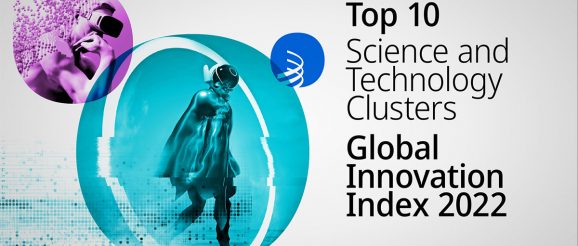Global Innovation Index’s Global Science & Technology Clusters: East Asia Dominates Top Ranking

Global Innovation Index’s Global Science & Technology Clusters: East Asia Dominates Top Ranking
Geneva,
September 14, 2022
PR/2022/894
Four of the world’s five biggest science and technology clusters are located in East Asia – one in Japan, two in China, one in Republic of Korea and the fifth in the United States – according to an early release from the 2022 edition of WIPO’s Global Innovation Index (GII).
Each year, the GII ranks the top-level innovative capacity of around 130 countries and economies around the world. In a pre-release ahead of its official September 29, 2022, global launch, the Global Innovation Index “Science and Technology Cluster” chapter looks to the ground to identify the highest local concentration of science and technology development.
Video: View the 10 biggest GII Science and Technology Clusters
Video: What is the Global Innovation Index (GII)?
Tokyo-Yokohama is the biggest cluster, followed by the Shenzhen-Hong Kong-Guangzhou (China and Hong Kong, China), Beijing (China), Seoul (Republic of Korea) and San Jose-San Francisco (United States) clusters. (See Table 1 – Biggest GII S&T Clusters).
In proportion to population, the Cambridge cluster in the United Kingdom and the Eindhoven area in the Netherlands/Belgium are the most S&T-intensive clusters, followed by Daejon in the Republic of Korea, San Jose-San Francisco and Oxford, UK. (See Table 2 – Most-Intensive GII S&T Clusters).
Local innovation clusters are critical to the vibrancy of national innovation ecosystems, so identifying them will help us understand where and how innovation is happening, and promote innovative activity as a powerful catalyst for jobs, investments, and growth.
Aside from the long-identified clusters of excellence in the U.S., Europe, Japan and the Republic of Korea, we see new S&T hotbeds in East Asia, particularly in China, but also in other middle-income economies, including in Brazil, India, Iran, Türkiye, and elsewhere.
In other findings:
About GII Science and Technology Clusters
Science and technology clusters are established through the analysis of patent-filing activity and scientific article publication, documenting the geographical areas around the world with the highest density of inventors and scientific authors.
WIPO locates and ranks science and technology clusters through a geocoding method, mapping addresses and names pulled from documents to a 96% accuracy.
The GII science and technology clusters are one element in the larger GII, which takes the pulse of the most recent trends in global innovation. The report ranks the innovation ecosystem performance of economies around the globe each year, while highlighting innovation strengths and weaknesses and particular gaps in innovation metrics. To capture as complete a picture of innovation as possible, the GII comprises around 80 indicators, including measures on the political environment, education, infrastructure and knowledge creation of each economy.
The GII can be used to monitor performance and benchmark developments against economies within the same region or income group classification.
About WIPO
The World Intellectual Property Organization (WIPO) is the global forum for intellectual property policy, services, information and cooperation. A specialized agency of the United Nations, WIPO assists its 193 member states in developing a balanced international IP legal framework to meet society’s evolving needs. It provides business services for obtaining IP rights in multiple countries and resolving disputes. It delivers capacity-building programs to help developing countries benefit from using IP. And it provides free access to unique knowledge banks of IP information.
For more information, please contact the News and Media Division at WIPO:
